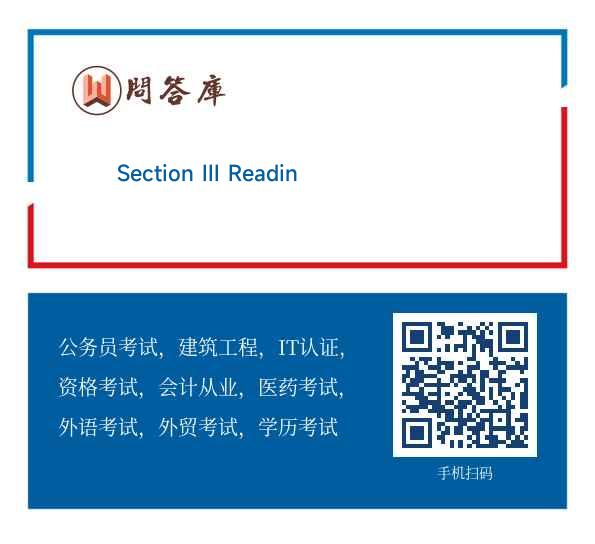Section III Reading Comprehension(60 minutes)P
问题详情
Section III Reading Comprehension
(60 minutes)
Part A
Directions :
Read the following four texts. Answer the questions below each text by choosing A, B, C orD. Mark your answers on ANSWER SHEET1.
Text 1
The U. S. Supreme Court has forbidden prayers in public schools, but many Americans cling to the idea that their educational system has a moral purpose. It is an idea common to both the Greeks and the medieval Church. In today"s world, the moral purpose of education takes non-religious forms: racialintegration, sex education, good citizenship. At the college level, the ambiguities become more complex. Should a morally objectionable person be allowed to teach? Should a morally objectionable doctrine be permitted?
Many people are understandably dismayed by such inspection. But would they prefer moral neutrality? Should engineers be trained to build highways without being taught any concern for the homes they displace? Should prospective corporate managers learn how to increase profits regard-less of pollution or unemployment? Just the opposite, according to Beyond the Ivoiy Tower, a new book by Harvard"s Bok, which calls for increased emphasis on " applied ethics. " (Writes Bok:"A university that refuses to take moral dilemmas seriously violates its basic obligations to society. " )
Religious colleges have always practiced a similar preaching. But some 500 schools now offer courses in the field. The Government supports such studies with a program known as EVIST, which stands for Ethics and Values in Science and Technology (and which sounds as though a computer had already taken charge of the matter). "The modern university is rooted in the scientific method, having essentially turned its back on religion," says Steven Muller, president of John Hopkins. "The scientific method is a marvelous means of inquiry,but it really doesn"t provide a value system. The biggest failing in higher education today is that we fall short in exposing students to values. "
Charles Muscatine, a professor of English at Berkeley and member of a committee that is analyzing liberal arts curriculums for the Association of American Colleges, is even harsher. He calls today"s education programs " a marvelous convenience for low-quality society. " The key goal of education, says Muscatine,should be "informed decision making that recognizes there is a moral component to life. "Instead, he says,most universities are " spreading the dangerous myth that tech- nical skills are more important than moral reasoning. "
41. The first paragraph implies that__________
[A] there is a conflict between laws and public opinions on the purpose of education.
[ B] the moral purpose of education varies in form. with the social situation.
[ C] Greeks and the medieval Church had the same moral purpose in education.
[ D] the moral purpose of education is to advocate religious beliefs.请帮忙给出正确答案和分析,谢谢!
参考答案
正确答案:B
第三部分阅读理解PartAText1参考译文美国最高法院禁止在公立学校里举行祈祷仪式,但是很多美国人坚持认为教育应该将伦理道德作为其目的之一。希腊人和中世纪的教会也都持有同样的观点。在当今世界,道德教育采取非宗教形式:种族融合,性教育,以及公民教育。道德教育在大学教育中显得更加复杂。一个不崇尚道德的人能教书吗?反对道德的课本能用于教学吗?很多人对这样的审视感到诧异,这是可以理解的。但是他们更倾向于道德中立吗?工程师应该被教育成只知道修建新的高速路而不关心拆迁家庭问题的人吗?未来的公司经理们是不是只要学习如何增加利润而不考虑污染和失业?根据哈佛大学校长Bok所写的一本新书《在象牙塔之外》,事实恰恰相反。这本书强调要重视“应用道德”。(Bok写道:一所拒绝严肃对待道德窘境的大学就是违背了其对社会基本的责任。)宗教大学一直在做类似的布道。但是现在已有大约500所学校开设了道德教育课程。政府通过“科技道德与价值观(听上去好像电脑已经掌控了整个事件)”-EVIST项目来支持道德教育。约翰·霍普金斯大学的校长史蒂芬·马勒说:“以科学为理念所建立的现代大学从本质上已经抛弃宗教。科学方法是一种不可思议的探索途径。但是它确实没有提供一套价值体系。当今高等教育最失败的地方就是不能向学生呈现什么才是价值。”查尔斯·马斯凯汀是伯克利大学的英语教授,同时也是美国大学联合会自由艺术课程环境分析委员会的成员,他的看法更加尖锐。他把现在的教育叫做“劣质社会的超便利捷径”。马斯凯汀说,教育的主要目的应该是“使人们在决策时认识到道德是生命的组成部分。”他说事实正好相反,多数大学在“散布危险的神话,即技术比道德推理更重要。”答案及精析41.B【精析】根据第一段第三句“Intoday'sworld,themoralpurposeofeducationtakesnon-religiousforms:racialintegration,sexeducation,goodcitizenship.”可知,在当今世界,道德教育采取非宗教形式:种族融合、性教育以及公民教育,由此可以判断出不同时代社会状况不一样,道德教育形式也不一样,故B选项正确,同时可知D选项陈述过于片面和绝对,故不选;第一段第一句只是提到美国最高法院禁止公立学校举行祈祷仪式,并不代表法律和公众在教育目的的观点上存在矛盾,故A选项错误;根据第一段前两句可知,希腊和中世纪的教会都认同道德教育应该是教育的目的之一,并不是说两者道德教育的目的一致,故C选项错误。
